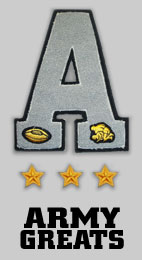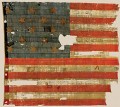Captain Gardiner, after being severely wounded toward the end of the battle, cried out, “I can give you no more orders my lads, do your best!
(Born D. C. , Ap’d D. C.)
Cadet of the Military Academy, Sep. 2, 1812, to Mar. 11, 1814, when he was graduated and promoted in the Army to Third Lieut., 1st Artillery, Mar. 11, 1814.
Indian chief, Halpatter-Tustenuggee gave this account “The men shouted and whooped, the officers shook their swords and swore, especially one officer, a little man, and a very brave man, who shook his sword at the soldiers and said “God-dam!” and whom no rifle ball could hit.”
It is to be regretted that the identity of the officer whose bravery won the admiration of his Indian foe is lost, perhaps forever, to history. Logical deduction leads to the conclusion that it was Captain Gardiner, the ranking officer of those who escaped the first volley unharmed, and upon whom, Major Dade and Captain Fraser having fallen, the command of the shattered detachment devolved, and who directed the hopeless defense until mortally wounded near the end of the second battle – his dead body, found outside the breastworks whose construction he had ordered, and at it most exposed angle, bearing silent but indisputable testimony to a courage that did not falter in the face of death itself.
It was Gardiner’s company which formed the principal unit of the small battalion,
and it was Gardiner upon whom the responsibility fell of conducting the desperate defense through five long hours. Dade’s name has been deservedly preserved in more than one memorial, while the one honor given Gardiner was to name for him a small military post on the banks of the Kissimmee river, (Fort Gardiner) which has long since been obliterated.
Perhaps the future may make some amends for this neglect of the past.
Served: in the War of 1812 – 1815 with Great Britain, in garrison at Ft. Columbus, N. Y., 1814 – 1815; at Portsmouth, N. H., 1815 – 1816; at the Military (Second Lieut., 1st Artillery, May 1, 1814), (Transferred to Corps of Artillery, May 12, 1814), Academy, 1816 – 1820, as Adjutant, Oct. 12, 1816, to Sep. 15, 1817, and from Feb. 10, 1819, to Mar. 9, 1820, – as Commandant of Cadets and Instructor of Infantry Tactics, Sep. 15, 1817, to Apr. 2, 1818, – and (First Lieut., Corps of Artillery, Apr. 20, 1818) as Instructor of Artillery, Sep. 15, 1817, to Feb. 1, 1820; in garrison at New York harbor, 1820; on Commissary duty, 1820 – 1821; in garrison at (First Lieut., 2d Artillery, in Re-organization of Army, June 1, 1821) Fort Mifflin, Pa., 1821 – 1824, – Ft. Delaware, Del., 1824 – 1827, – and Augusta Arsenal, Ga., 1827 – 1830; in Cherokee Nation, 1830 – 1831; in garrison at Fort (Bvt. Captain, Apr. 20, 1828, for Faithful Service Ten Years in one Grade) Marion, Fla., 1831 – 1832, and Augusta Arsenal, Ga., 1832 – 1833; in Cherokee (Captain, 2d Artillery, Nov. 3, 1832), Nation, 1833; in garrison at Ft. Mitchell, Ala., 1833 – 1834, Ã∞â√ıÃ≠¢Ã∞¢â╢¢Ã≠¢Ã∞¢â╢¢Ã≠° Ft. Jackson, La., 1834, – Covington, La., 1834, – Ft. Jackson, La., 1834 – 1835, – and Ft. Pickens, Fla., 1835; and in the Florida War, being engaged in Dade’s desperate Battle with the Seminole Indians, where “the whole command, save three, fell without an attempt to retreat.”
Killed, at “Dade Massacre”, Fla., Dec. 28, 1835.
Buried, St. Augustine National Cemetery, St. Augustine, FL.
The Author Bill Thayer’s Note:
General Hitchcock, who passed over the battle-ground Feb. 22, 1836, reports: “Along the north and west faces of the triangular breastwork, formed by felled trees, were about thirty bodies, mere skeletons, although much of the clothing was left upon them. They were lying, almost every one of them, in precisely the position they must have occupied during the fight, – their heads next to the logs over which they had delivered their fire, and their bodies stretched with striking regularity parallel to each other. They had evidently been shot dead at their posts, and the Indians had not disturbed them, except by taking the scalps of most of them … The advance guard, doubtless, fell during the first attack. It was during a cessation of fire that the little band still remaining, about thirty in number, threw up the triangular breastwork, which, from the haste with which it was constructed, was necessarily defective and could not protect the men on the second attack.”
The action lasted from 8 A.M. to 4 P.M. The U. S. troops amounted to 108, and the savage foe to 800 Seminole Indians, and 100 negroes. While a man could load a musket, the firing was continued. Captain Gardiner, next to the last surviving officer, fell, pierced by five or six shots, his mortal wound being in the breast.
A beautiful monument, of white Italian marble, was erected at West Point, to “Dade and his Command.”
A comment must be made – the monument sits just inside the Cemetery gate – a very ill advised location for an Officer who lost nearly his entire Command.
Thayer’s Note: For full details of the fight in which Capt. Gardiner lost his life, still now usually referred to as “Dade Massacre”, and his burial in Florida, see “Alfred Mudge”‘s Memorials, pp383 – 393, and especially “The Dade Massacre”, Florida Historical Society Quarterly 5:123 – 138 (1927), the author of which conjectures Gardiner to have been exceptionally courageous, and the principal hero in that fight.
http://penelope.uchicago.edu/Thayer/E/Gazetteer/People/Robert_Mudge/Alfred_Mudge_appendix*.html




















































































































